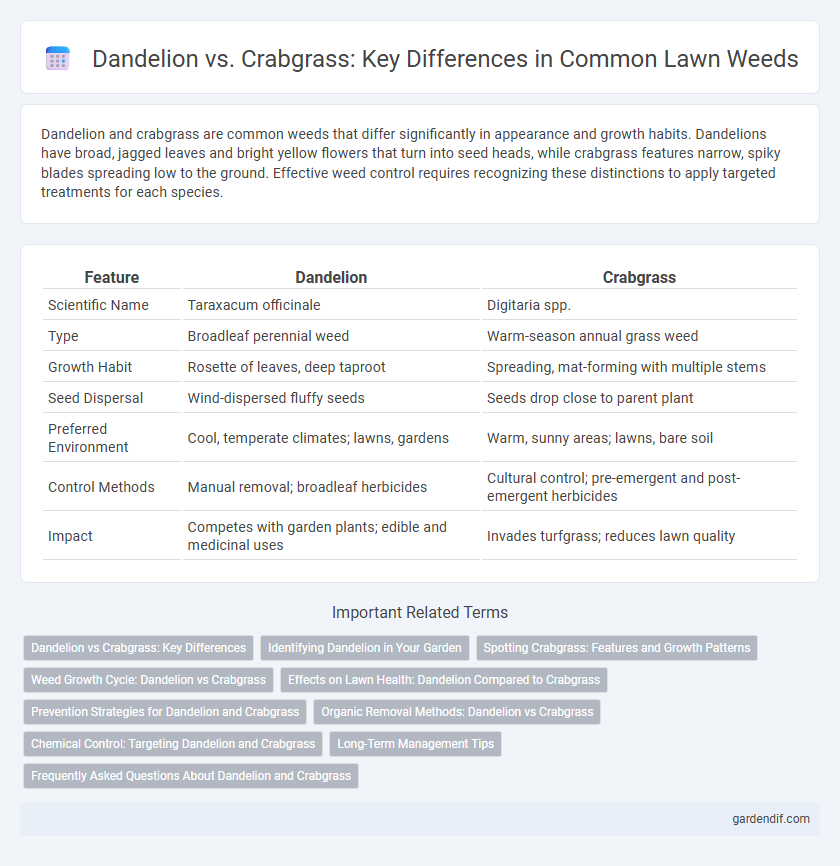
Dandelion vs crabgrass Illustration
Dandelion and crabgrass are common weeds that differ significantly in appearance and growth habits. Dandelions have broad, jagged leaves and bright yellow flowers that turn into seed heads, while crabgrass features narrow, spiky blades spreading low to the ground. Effective weed control requires recognizing these distinctions to apply targeted treatments for each species.
Table of Comparison
| Feature | Dandelion | Crabgrass |
|---|---|---|
| Scientific Name | Taraxacum officinale | Digitaria spp. |
| Type | Broadleaf perennial weed | Warm-season annual grass weed |
| Growth Habit | Rosette of leaves, deep taproot | Spreading, mat-forming with multiple stems |
| Seed Dispersal | Wind-dispersed fluffy seeds | Seeds drop close to parent plant |
| Preferred Environment | Cool, temperate climates; lawns, gardens | Warm, sunny areas; lawns, bare soil |
| Control Methods | Manual removal; broadleaf herbicides | Cultural control; pre-emergent and post-emergent herbicides |
| Impact | Competes with garden plants; edible and medicinal uses | Invades turfgrass; reduces lawn quality |
Dandelion vs Crabgrass: Key Differences
Dandelion (Taraxacum officinale) and crabgrass (Digitaria spp.) differ primarily in their growth habits and life cycles; dandelions are perennial broadleaf weeds with deep taproots, while crabgrass is an annual grassy weed with shallow fibrous roots. Dandelions produce bright yellow flowers that turn into seed heads with fluffy parachutes, facilitating wind dispersal, whereas crabgrass spreads through fast-growing, spreading stems that root at nodes, forming dense mats. Control methods vary as dandelions respond well to broadleaf herbicides targeting deep roots, while crabgrass requires pre-emergent herbicides focused on grass seeds and careful lawn maintenance.
Identifying Dandelion in Your Garden
Dandelion leaves are characterized by their jagged, toothed edges and bright green color, often forming a basal rosette close to the ground, while crabgrass has broader, more elongated leaves that grow in a spreading manner. Dandelions produce a distinctive yellow flower head that turns into a white, fluffy seed ball, a feature absent in crabgrass. Identifying these traits helps gardeners target dandelion removal effectively without confusing it with crabgrass infestations.
Spotting Crabgrass: Features and Growth Patterns
Crabgrass is a warm-season annual weed characterized by its spreading growth habit, coarse texture, and light green color, forming dense mats that crowd out desirable grass. Its leaves are wider and have pointed tips, growing in a prostrate manner before sending up flowering stems with finger-like seed heads. Unlike dandelion's rosette growth and taproot system, crabgrass thrives in thin, bare soil patches and proliferates rapidly during hot, dry conditions, making early identification essential for effective control.
Weed Growth Cycle: Dandelion vs Crabgrass
Dandelions undergo a perennial growth cycle with deep taproots that enable survival through winter and rapid spring regrowth, producing flowers, seeds, and new plants. Crabgrass follows an annual growth cycle, germinating from seed in warm soil, flourishing in summer, and dying off with the first frost. Understanding these distinct life cycles is crucial for effective weed control strategies targeting dandelion's persistent regeneration versus crabgrass's seasonal seed spread.
Effects on Lawn Health: Dandelion Compared to Crabgrass
Dandelions contribute to soil aeration and provide early spring nectar for pollinators, offering some ecological benefits despite their invasive nature in lawns. Crabgrass, on the other hand, aggressively spreads and outcompetes desirable turfgrass, resulting in a thin, patchy lawn that is more susceptible to erosion and drought stress. While dandelions can coexist with grass, crabgrass typically damages lawn health by reducing overall turf density and uniformity.
Prevention Strategies for Dandelion and Crabgrass
Preventing dandelion involves maintaining thick, healthy turf through proper mowing, adequate fertilization, and regular watering to reduce bare spots where seeds can germinate. Crabgrass prevention relies on applying pre-emergent herbicides in early spring before soil temperatures reach 55degF, alongside promoting dense grass growth to outcompete crabgrass seeds. Both weeds require consistent lawn care and timely interventions to minimize their establishment and spread effectively.
Organic Removal Methods: Dandelion vs Crabgrass
Organic removal methods for dandelions often include hand-pulling and the application of natural vinegar solutions, which effectively break down the broadleaf structure without harming surrounding plants. Crabgrass control organically relies heavily on maintaining thick, healthy turf through proper mowing, aeration, and overseeding with competitive grass species, as it thrives in thin or weak lawns. Corn gluten meal, a natural pre-emergent herbicide, can suppress crabgrass seed germination but is generally ineffective against established dandelions.
Chemical Control: Targeting Dandelion and Crabgrass
Effective chemical control of dandelion and crabgrass involves selective herbicides such as 2,4-D and dicamba for broadleaf weeds like dandelions and pre-emergent herbicides like pendimethalin for crabgrass. Applying post-emergent herbicides during early growth stages enhances control efficacy by disrupting photosynthesis and root development. Proper timing, application rate, and environmental conditions are critical to maximizing weed suppression while minimizing damage to desirable turfgrass.
Long-Term Management Tips
Long-term management of dandelion and crabgrass requires persistent monitoring and targeted control strategies to prevent their spread and establishment. Incorporating a thick, healthy lawn through regular mowing, proper watering, and fertilization minimizes open soil areas where these weeds can take hold. Applying selective herbicides during optimal growth stages, combined with soil aeration and overseeding, ensures sustainable suppression of both dandelion's deep taproots and crabgrass's aggressive seed production.
Frequently Asked Questions About Dandelion and Crabgrass
Dandelions and crabgrass are common lawn weeds that often confuse homeowners due to their different growth habits and control methods. Dandelions are broadleaf perennials with deep taproots, making them challenging to remove, while crabgrass is an annual grassy weed that thrives in warm seasons and spreads quickly. Effective management includes pre-emergent herbicides for crabgrass and broadleaf herbicides or manual removal for dandelions to maintain a healthy lawn.
Dandelion vs crabgrass Infographic

 gardendif.com
gardendif.com